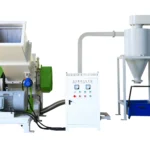Keep Your Plastic Granulator in Top Condition: Essential Maintenance and Care Tips
Choose the correct technical jargon to ensure optimal performance and a long service life.
Why Regular Maintenance is Essential
A structured maintenance program for your plastic granulator offers clear advantages:
- Maximize lifespan and ROI – Preventive maintenance detects small issues before they become costly defects.
- Consistent product quality – Sharp blades, clean screens, and proper calibration ensure uniform particle size; dull blades or clogged screens lead to dust and fines.
- Increased efficiency and less downtime – A well-maintained granulator operates more smoothly, consumes less energy, and is less prone to failure.
- Enhanced safety – Regular inspection of safety caps, emergency stops, electrical connections, and blade integrity prevents accidents.
Introduction to the granulator – core components
Although designs may vary, most plastic granulators share the same basic structural components:
| Component | Function |
|---|---|
| Feed Hopper (Hopper) | Feeds plastic waste |
| Cutting Chamber | Houses the rotor and blades |
| Rotor | Rotor blade assembly |
| Rotor knives (Fly Knives) | Performing the first cut |
| Stator/bed knives | Fixed mounting; critical gap with rotor knives determines cutting quality |
| Sieve | Determines the final particle size through mesh size; material remains in the chamber until it is small enough |
| Drive system | Electric motor with V-belts or direct coupling |
| Discharge bin/draw-out system | Catch the granulated pellets |
(Visual advice: A labeled flowchart improves comprehension.)
Maintenance Checklist: Time-based Planning
Adjust the following template to your machine, operating hours, and material type.
Daily (before/during/after each shift):
- Visual inspection: Loose bolts, leaks, damaged covers?
- Listen: unusual sounds (cracking, clattering, excessive vibration).
- Feeding hopper: free of obstructions or foreign objects.
- Cutting chamber (after shutdown & LOTO): check for material accumulation or obstructions.
- Discharge bin: empty in time to prevent backflow.
- Safety Measures: Emergency stops accessible, guards securely fastened.
Weekly:
- Blade Inspection (LOTO): rotor blades and stator blades for straightness, cracks, wear pattern.
- Sieve Inspection: for cracks, deformation, blockages; clean if necessary.
- Drive Belts: tension & condition (for cracks, fraying).
- Lubricate bearings (model-dependent) according to factory specifications.
- Tighten fasteners: critical bolts (blade/sieve bolts).
- General cleaning of the machine and surrounding area.
Monthly:
- Thorough cleaning of cutting chamber, sieve, and collection area.
- Check and adjust the split control to factory settings.
- Storage state: manually turn, listen, and measure temperature (IR thermometer).
- Electrical connections: visually inspect for loose wires/discolored clamps.
- Test safety interlocks.
Half-yearly/Annually:
- Measure and grind or replace; always mount in sets and balanced.
- Replace bearings according to hour or condition limit.
- Drive train: thoroughly inspect motor, coupling, and belts / carry out preventive renewal.
- Replace screen if worn or damaged.
- Complete machine inspection: frame, welding, component integrity.
Deepening in Critical Maintenance Tasks
Measurement (rotor & stator)
Importance: sharp and precise cutting for high slicing efficiency, lower load, and energy saving.
Actions: regular inspection, correct spline adjustment, timely sharpening/exchange, always work with PPE.
Sieve
Importance: uniform particle size and throughput.
Actions: check for blockage or damage, thorough cleaning, immediate replacement in case of cracks or severe wear.
Bearings
Importance: bear high loads and speeds; failure can cause catastrophic damage.
Actions: Lubricate strictly according to specifications, avoid over-lubrication, monitor temperature and noise levels.
Drive (belt/motor)
Importance: Efficient power transmission.
Actions: Check belt tension and alignment, assess wear, ensure motor ventilation is clear.
Troubleshooting – How Good Maintenance Helps
| Problem | Possible Cause (maintenance) | Solution |
|---|---|---|
| Poor cutting quality / excessive fines | Dull blades, incorrect blade gap, clogged screen | Grinding/Swapping Blades, Adjust Gap, Clean/Replace Screen |
| Low Capacity | Dull Blades, Clogged Screen, Slack Drive Belts | Grind Blades, Clean Screen, Tension Belts |
| Excessive Noise/Vibration | Loose Blades/Bolts, Faulty Bearings, Unbalanced Rotor | Tighten Bolts, Inspect/Replace Bearings, Balance Rotor |
| Motor Too Hot | Dull Blades, Material Build-up, Incorrect Feed Voltage | Grind Blades, Clean Machine, Check Electrosupply |
| Unblock Machine | High feeding speed, dull blades, foreign objects | Reduce input, sharpen blades, remove obstructions |
(Optional: Export this table to Google Sheets for use on the work floor.)
Safety First: Lockout/Tagout
Maintenance in the cutting chamber may only be performed when the machine is completely de-energized and LOTO procedures must be strictly followed.
- Always lock or label before maintenance.
- Never reach into the hopper or cutting chamber when the machine is rotating or standing under tension.
- Wear appropriate PBM: safety goggles, cut-resistant gloves, hearing protection.
- Replace all caps and verify emergency stops before restarting.
- Keep the area around the granulator clean.
Quality matters: OEM parts & professional service
Aftermarket parts may seem cheaper, but OEM parts ensure fit, material quality, and performance – crucial for blades, screens, and bearings. In complex repairs, involving a qualified service technician or the manufacturer is often faster, cheaper, and safer than attempting to do it yourself.
Conclusion
Your plastic granulator is a core asset. By treating maintenance as a priority – with a focus on blades, screens, bearings, and safety checks – you maximize productivity, lifespan, and safety.
Proactive maintenance is always more cost-effective and less disruptive than reactive repairs.


 Granulator for Recycling WPC Material (Wood-Plastic Composite)
Granulator for Recycling WPC Material (Wood-Plastic Composite) Granulators for Hard Plastics
Granulators for Hard Plastics